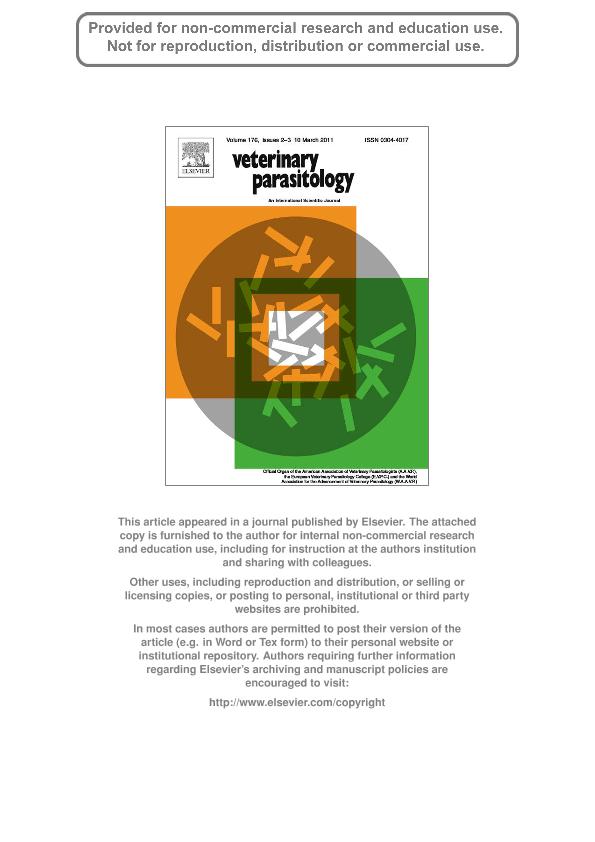Artículo
Epidemiology of canine heartworm in its southern distribution limit in South America: Risk factors, inter-annual trend and spatial patterns
Vezzani, Dario ; Carbajo, Anibal Eduardo
; Carbajo, Anibal Eduardo ; Fontanarrosa, María F.; Scodellaro, Carla F.; Basabe, Julia; Cangiano, Griselda; Eiras, Diego Fernando
; Fontanarrosa, María F.; Scodellaro, Carla F.; Basabe, Julia; Cangiano, Griselda; Eiras, Diego Fernando
 ; Carbajo, Anibal Eduardo
; Carbajo, Anibal Eduardo ; Fontanarrosa, María F.; Scodellaro, Carla F.; Basabe, Julia; Cangiano, Griselda; Eiras, Diego Fernando
; Fontanarrosa, María F.; Scodellaro, Carla F.; Basabe, Julia; Cangiano, Griselda; Eiras, Diego Fernando
Fecha de publicación:
03/2011
Editorial:
Elsevier Science
Revista:
Veterinary Parasitology
ISSN:
0304-4017
Idioma:
Inglés
Tipo de recurso:
Artículo publicado
Clasificación temática:
Resumen
This study was aimed at understanding some aspects of the canine heartworm epidemiology in the southern distribution limit of the parasite in South America. With this objective, 19,298 blood samples of owned dogs from 65 localities of 13 municipalities of Buenos Aires Province were tested for Dirofilaria immitis circulating microfilariae and/or female antigens. The overall heartworm prevalence was 1.63% by microhematocrit tube technique (n = 19,136), 3.65% by modified Knott (n = 713), and 14.41% by antigen test kit (n = 118). Microfilaremic dogs showed a median of 1933 microfilariae per millilitre (q1 = 375, q3 = 5625, n = 100). Male dogs belonging to breeds of short hair and large size recorded significantly higher prevalences than the other categories. Also, the prevalence increased significantly with the age and only dogs younger than 12 months were not found infected. A clear decreasing trend of the annual prevalence was observed during the whole study period, from 3.91% in 2001 to 1.17% in 2006. D. immitis-infected dogs were detected in 32 localities of 9 municipalities (prevalence range: 0.2-6.7%). Generalized linear models were used to assess associations between heartworm prevalence and environmental variables. The resulting significant models were univariate and included variables related with soil cover and human population density. The best model predicted maximum heartworm prevalences around middle values of bare soil cover, and lower at high and low covers. According to our analyses, canine heartworm infection in urban temperate Argentina could be described as relatively low, endemic, and spatially heterogeneous. Host and environmental factors affecting heartworm transmission at local level were identified and discussed.
Archivos asociados
Licencia
Identificadores
Colecciones
Articulos(IEGEBA)
Articulos de INSTITUTO DE ECOLOGIA, GENETICA Y EVOLUCION DE BS. AS
Articulos de INSTITUTO DE ECOLOGIA, GENETICA Y EVOLUCION DE BS. AS
Articulos(SEDE CENTRAL)
Articulos de SEDE CENTRAL
Articulos de SEDE CENTRAL
Citación
Vezzani, Dario; Carbajo, Anibal Eduardo; Fontanarrosa, María F.; Scodellaro, Carla F.; Basabe, Julia; et al.; Epidemiology of canine heartworm in its southern distribution limit in South America: Risk factors, inter-annual trend and spatial patterns; Elsevier Science; Veterinary Parasitology; 176; 2-3; 3-2011; 240-249
Compartir
Altmétricas



